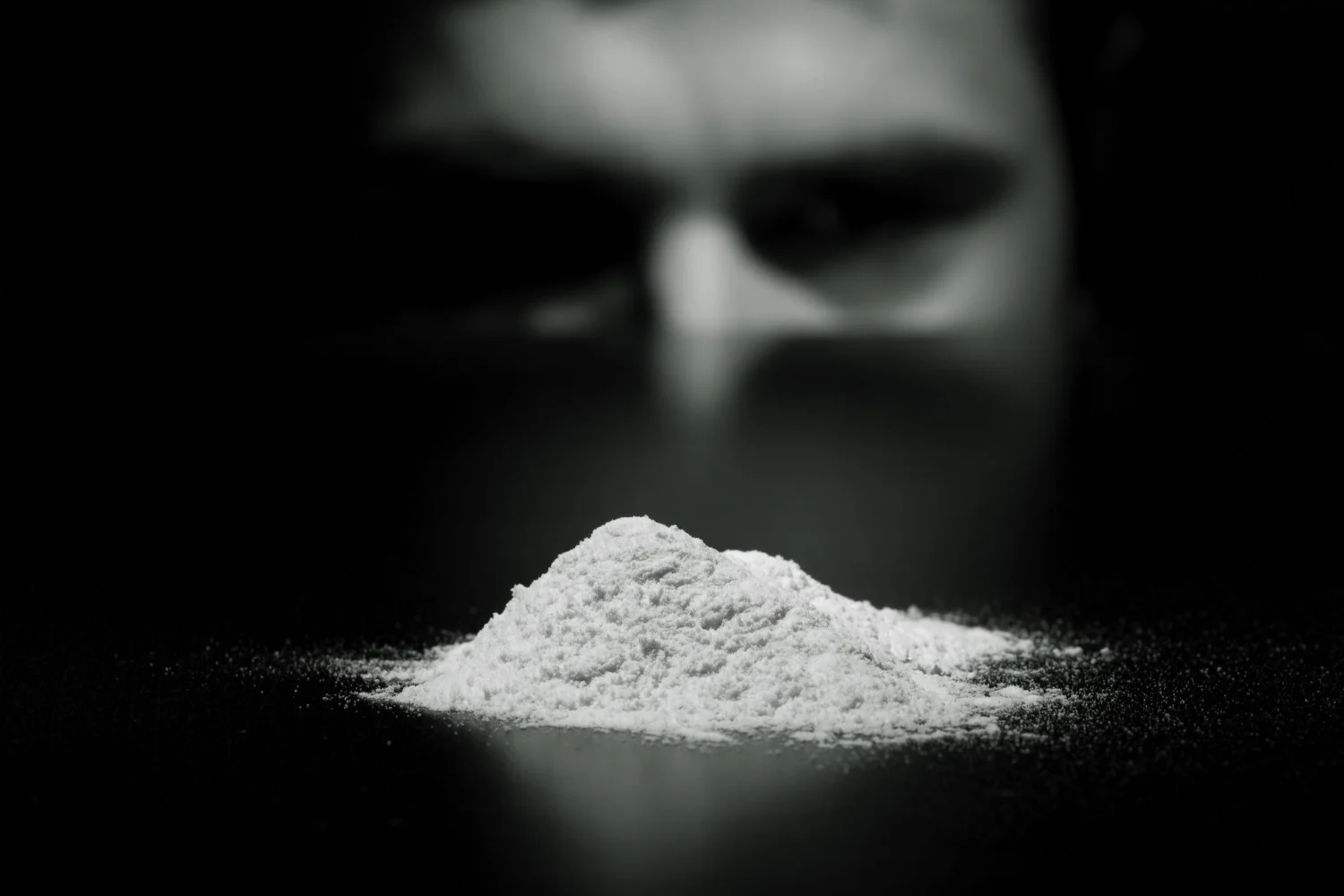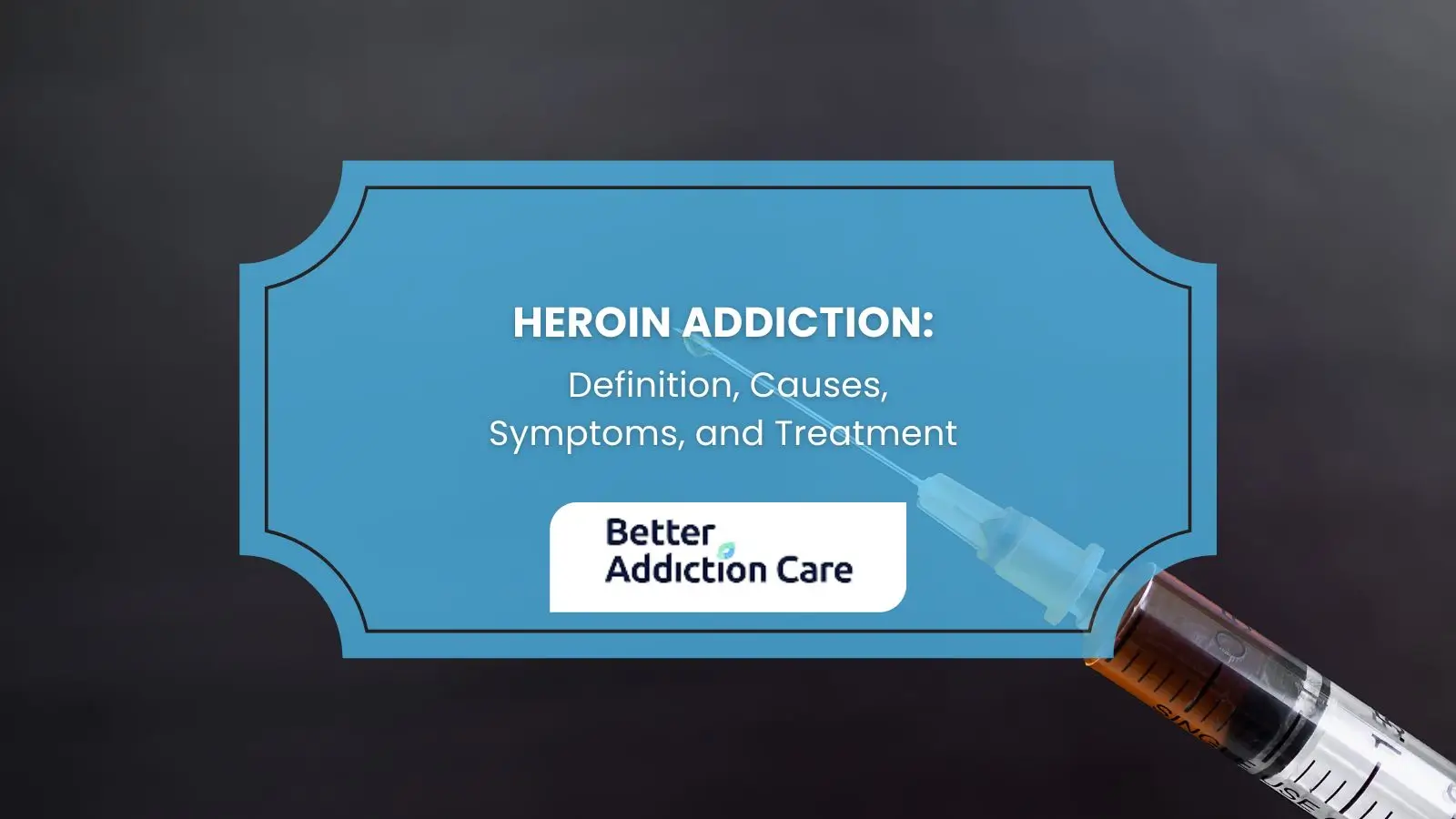Crystal Meth Addiction: Definition, Causes, Symptoms, Effects, and Treatment Methods
Crystal meth addiction is a severe substance use disorder that involves the abuse of methamphetamine, a powerful stimulant that affects the central nervous system. Crystal meth addiction starts with casual and fun use but quickly escalates due to the drug’s highly addictive nature.
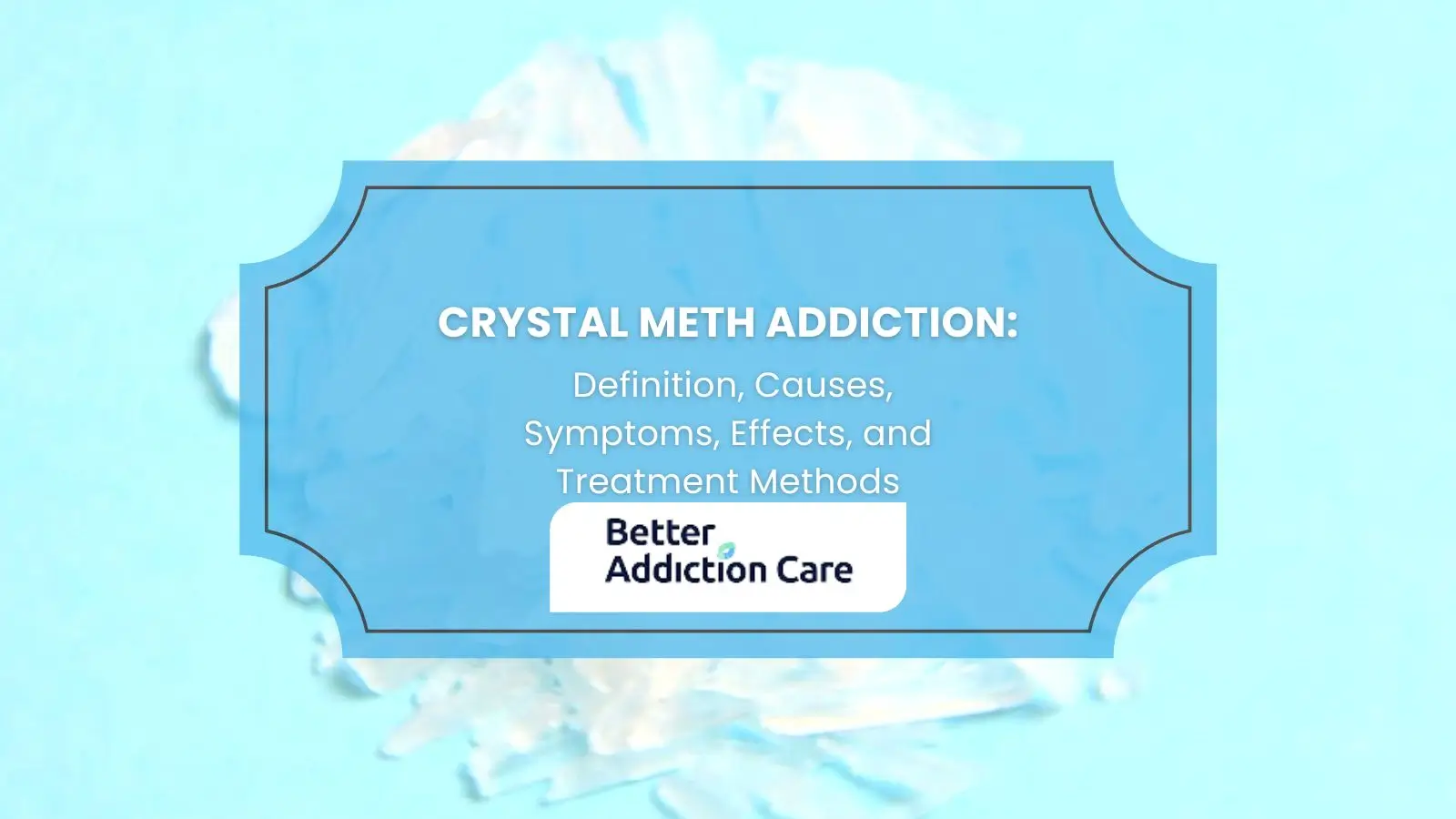
Crystal meth addiction is a severe substance use disorder that involves the abuse of methamphetamine, a powerful stimulant that affects the central nervous system. Crystal meth addiction starts with casual and fun use but quickly escalates due to the drug’s highly addictive nature.
Causes of crystal meth addiction typically include changes in brain chemistry and a mix of genetic, psychological, and environmental factors, such as family history of substance abuse, mental health disorders, or exposure to drug use. Symptoms of crystal meth addiction include teeth or gum damage, strange sleeping patterns, dilated pupils, obsessively picking at hair, jerky or erratic movements, mood swings, and psychotic behavior.
The effects of crystal meth addiction are serious and lead to long-term damage to the brain, heart, and other organs, as well as social and financial problems. Treatment methods for crystal meth addiction include detoxification, cognitive-behavioral therapy (CBT), medications, long-term rehab programs, motivational rewards, and support groups.
What is Crystal Meth Addiction?
Crystal meth addiction is a chronic and powerful dependency and addiction on methamphetamine. Methamphetamine addiction affects brain function and causes intense cravings, leading to compulsive drug-seeking behaviors and dependence, according to the research titled “The Neurobiology of Methamphetamine Addiction and the Potential to Reduce Misuse Through Conjugate Vaccines Targeting Toll-Like Receptor 4” by Savita Prasad and Phoebe S Mathew.
Methamphetamine, or meth, is a highly addictive stimulant known for its quick and intense effects on the brain and body. Methamphetamine is chemically similar to amphetamine and affects the central nervous system by increasing dopamine levels and giving feelings of euphoria and energy. These effects are short-lived, which is why users take repeated doses and become addicted, as stated in the study “The impact of methamphetamine use and dependence” by Bevan Rowland and Jeremy Davey.
What is the origin of Meth?
The origin of meth dates back to the early 20th century as a man-made stimulant. Meth was first synthesized in Japan in 1893, developed from amphetamine to treat conditions like nasal congestion and fatigue. During World War II, soldiers from various countries used methamphetamine to stay awake and energized, and it was later widely prescribed for weight loss and depression. Its highly addictive properties became evident by the 1970s and officials declared it a controlled substance.
How is Crystal Meth made?
Crystal meth is made through a chemical process that starts with pseudoephedrine, a common ingredient in cold medications. Professionals in illegal laboratories chemically alter using toxic substances such as battery acid, drain cleaner, and other hazardous chemicals to produce methamphetamine crystals. This process is extremely dangerous and produces harmful byproducts, which is why meth labs are a health hazard and produce environmental waste, and are banned from operating legally.
How is Crystal Meth consumed?
Crystal methamphetamine (meth) is consumed by smoking, injecting, snorting, or swallowing. Meth reaches the brain quickly when smoked or injected and gives an intense and rapid high. Snorting meth takes slightly to give a high but still leads to addiction. Swallowing or ingesting meth in pill form has the slowest effect but leads to a strong dependency.
How Common is Crystal Meth Addiction?
Crystal meth addiction is common in the US because approximately 1.6 million people reported using methamphetamine within the past year in 2021, according to the research report “What is the scope of methamphetamine use in the United States?” by the National Institute on Drug Abuse.
Rates of overdose mortality related to methamphetamine use have also surged, particularly among those who mix meth with opioids, which was linked to nearly half of all psychostimulant-related overdose deaths in 2017, according to the research titled “Methamphetamine Use, Methamphetamine Use Disorder, and Associated Overdose Deaths Among US Adults” published by JAMA Psychiatry. methamphetamine use increased by nearly 60% from 2016 to 2019 among adults aged 26 and older, while methamphetamine use disorder (MUD) grew by about 33% over the same period.
How Long Does Methamphetamine Stay in Your Body?
Methamphetamine stays in your body for 24 hours to 3 months, depending on factors like detection criteria, dose, frequency of use, and individual metabolism. One-time use of meth stays in the bloodstream for 24-72 hours, while it is detected in urine for up to a week, and in hair follicles for up to three months. Constant and frequent use of meth prolongs the timelines of detection.
What are the Causes of Crystal Meth Addiction?
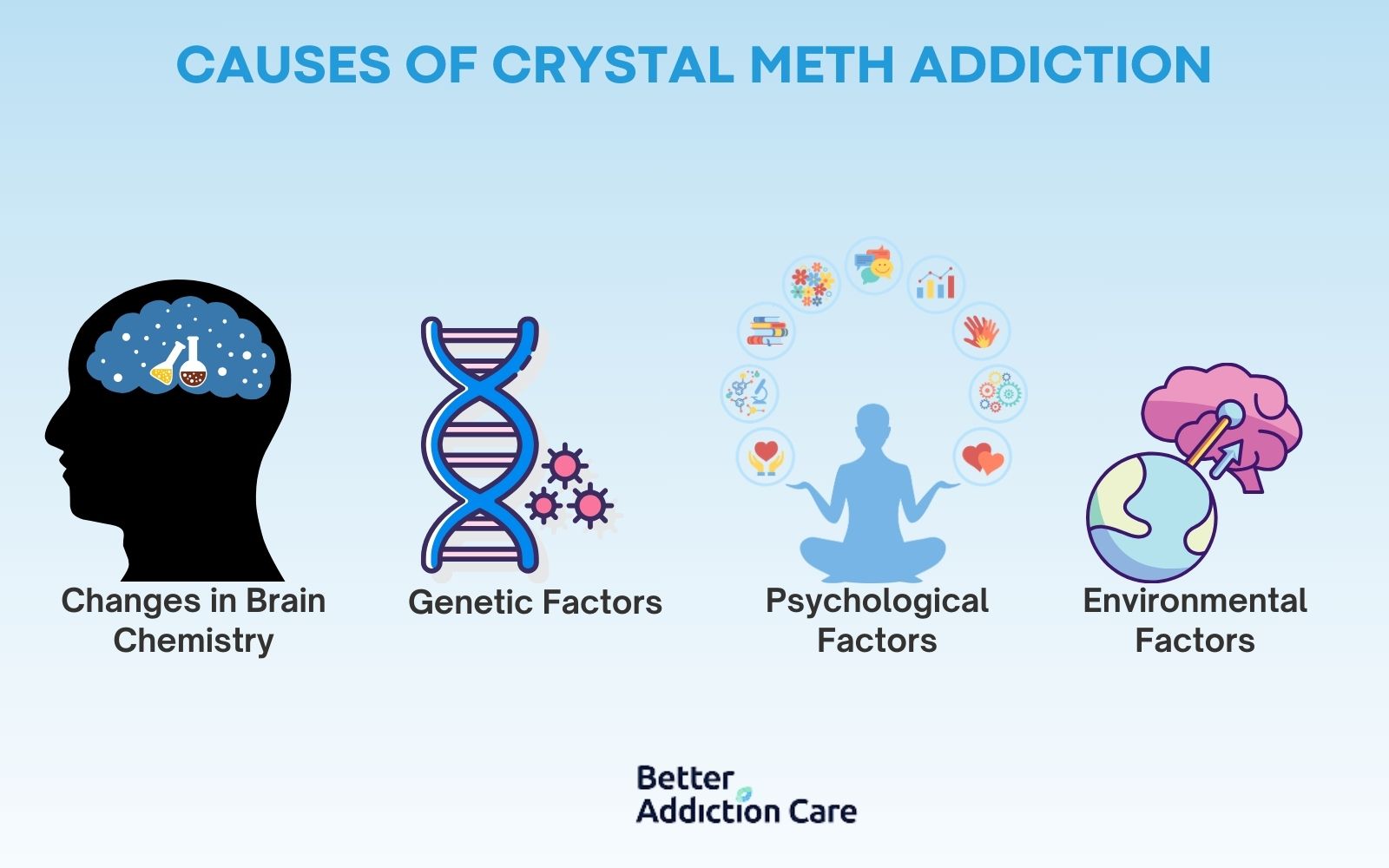
The causes of crystal meth addiction are changes in brain chemistry and genetic, psychological, and environmental factors.
These causes are explained below.
-
Changes in Brain Chemistry: Changes in brain chemistry occur because methamphetamine impacts the brain’s dopamine system and increases dopamine release. The dopamine release disturbs the brain chemistry that leads to dependency as the brain requires more meth to achieve the same effects, increasing the risk of addiction, according to the 2018 study “Alteration of Brain Structure With Long-Term Abstinence of Methamphetamine by Voxel-Based Morphometry” by Jun Zhang, Jun Liu, and Ru Yang.
-
Genetic Factors: Genetic factors such as a family history of substance abuse play a significant role in the development of crystal meth addiction, as stated in the study “Researchers Identify Gene Possibly Linked with Methamphetamine Addiction” published by the Boston University. Teens, young adults, and adults with a family history of substance abuse or certain genetic traits may be more vulnerable to meth addiction.
-
Psychological Factors: Psychological factors and mental health issues such as depression, anxiety, and trauma-related disorders increase the likelihood of meth addiction, according to the 2023 study “Identifying the Factors Affecting Methamphetamine Use: A Scoping Review” by Azam Rastegari published in the National Library of Medicine. People seek help from meth to self-medicate and alleviate psychological distress.
-
Environmental Factors: Environmental factors such as exposure to environments where meth is commonly used or accessible increase the risk of addiction, according to the study “Risk factors for methamphetamine use in youth: a systematic review” by Kelly Russell, Donna M Dryden, and Yuanyuan Liang. Socioeconomic stressors, peer pressure, and high-stress environments contribute to meth use and dependency.
What are the Signs & Symptoms of Crystal Meth Addiction?
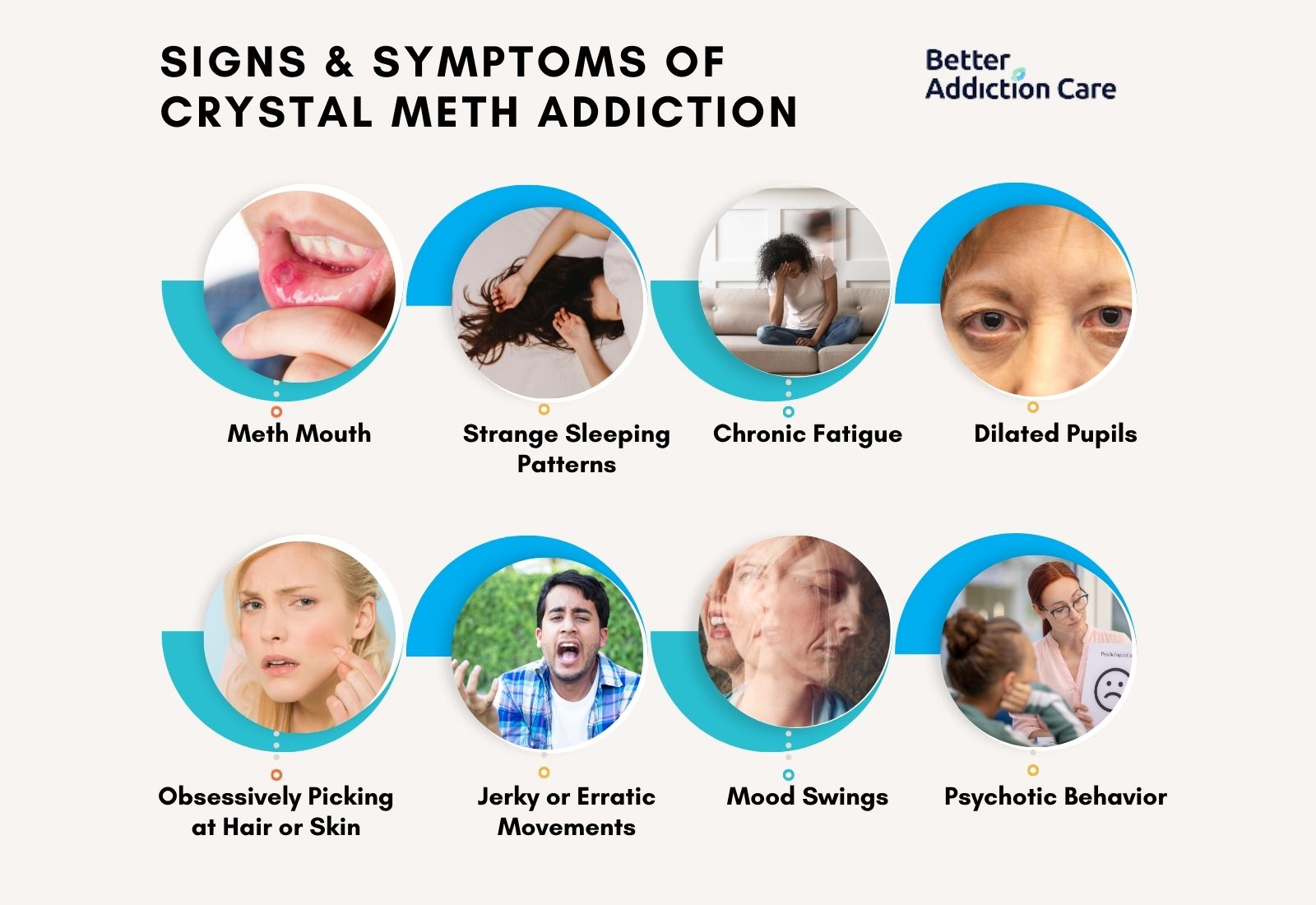
The signs and symptoms of crystal meth addiction are meth mouth, strange sleeping patterns, chronic fatigue, dilated pupils, obsessively picking at hair, jerky or erratic movements, mood swings, and psychotic behavior.
These signs and symptoms are listed below.
-
Meth Mouth: Meth mouth is the teeth or gum damage after chronic meth use. Meth mouth causes severe dental decay, gum disease, and tooth loss. The acidic nature of meth, combined with poor hygiene and dry mouth, leads to rapid tooth decay, as stated in the study “Meth Mouth—A Growing Epidemic in Dentistry?” by Andreas Pabst published in the National Library of Medicine.
-
Strange Sleeping Patterns: Meth users experience irregular sleep, either staying awake for extended periods or falling into deep, prolonged sleep following a binge, as stated in the 2021 study “Polysomnographic survey of sleep architecture in patients with methamphetamine dependence during remission” by Amir Rezaei-Ardani and Fariborz Rezaei-Talab.This cycle disrupts normal sleeping patterns and leads to severe exhaustion and insomnia.
-
Chronic Fatigue: Chronic fatigue occurs as meth wears off and users feel extreme tiredness due to the intense energy drain caused by the drug's stimulant effects. Fatigue usually becomes chronic because of disturbed sleeping patterns and the struggle to manage their energy levels without the drug.
-
Dilated Pupils: Dilated pupils occur when meth stimulates the nervous system and leads to visibly enlarged pupils. This physical response is due to meth's impact on the body's "fight or flight" response, creating heightened alertness and arousal, according to the research titled “Methamphetamine” by Rama Yasaei and Abdolreza Saadabadi published in the National Library of Medicine.
-
Obsessively Picking at Hair or Skin: Meth users feel sensations of itching or bugs crawling on the skin which leads to compulsive picking and scratching, according to the article titled “Methamphetamine Abuse” published by Psychopedia. Constant skin and hair picking results in sores, scars, and skin infections.
-
Jerky or Erratic Movements: Meth causes repetitive, twitchy movements or tics as it over-stimulates the central nervous system. These movements are involuntary and become more intense with increased meth use.
-
Mood Swings: Mood swings, such as intense and emotional highs and lows are common with meth use. Individuals feel irritation, anxiety, paranoia, or anger as the drug effects fluctuate.
-
Psychotic Behavior: Long-term meth use leads to severe psychological effects, including paranoia, hallucinations, and delusions. Meth-induced psychosis makes users aggressive, distrustful, and disconnected from reality, leading to potential harm to themselves or others, according to the research paper titled “Methamphetamine Psychosis” by McKetin, R., McLaren, J., and Kelly, E. (2005).
What are the Effects of Crystal Meth Addiction?
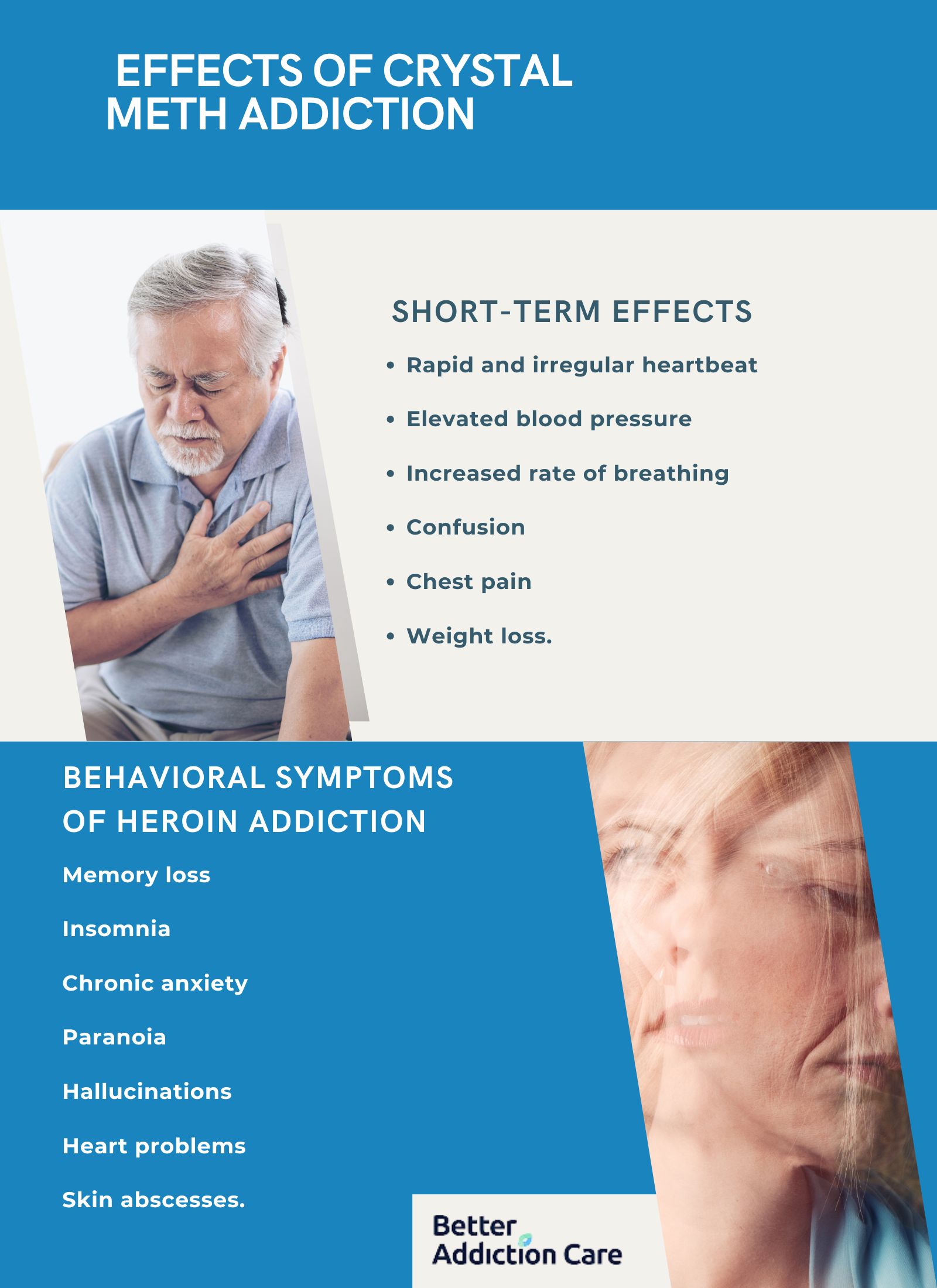
The effects of crystal meth addiction are classified into two categories, short-term and long-term effects.
These effects are described below.
Short-term Effects
Short-term effects of crystal meth addiction are rapid and irregular heartbeat, elevated blood pressure, increased rate of breathing, confusion, chest pain, and weight loss.
-
Rapid and Irregular Heartbeat: Meth use causes the heart to beat faster than usual, increasing the risk of cardiovascular strain and palpitations, according to the 2013 study titled “Effect of Methamphetamine Dependence on Heart Rate Variability.”
-
Elevated Blood Pressure: Meth’s stimulant properties lead to a quick rise in blood pressure, putting stress on the arteries and increasing the risk of stroke or heart attack.
-
Increased Rate of Breathing: Increased rate of breathing is when meth increases the respiratory rate which causes individuals to feel out of breath and even leads to hyperventilation in some cases.
-
Confusion: Meth use disturbs the normal brain activity and leads to confusion, especially as the drug’s effects wear off.
-
Chest Pain: Meth users experience chest pain as the drug over-stimulates the heart and cardiovascular system. Chest pain signals strain on the heart or, in severe cases, impending cardiac events.
-
Weight Loss: Meth addiction leads to rapid and often dangerous weight loss due to a lack of proper nutrition as meth suppresses appetite.
Long-term Effects
The long-term effects of meth addiction are memory loss, insomnia, chronic anxiety, paranoia, hallucinations, heart problems, and skin abscesses.
-
Memory Loss: Chronic meth use damages brain cells and impairs memory and cognitive function, leading to long-term memory issues even after stopping use, according to the research titled “What are the long-term effects of methamphetamine misuse?” published by the National Institute on Drug Abuse.
-
Insomnia: Long-term meth users suffer from chronic insomnia. They face difficulty in sleeping during withdrawal, which triggers other health issues.
-
Chronic Anxiety: Meth’s impact on neurotransmitters leads to chronic anxiety disorders that stay long even after drug use has stopped.
-
Paranoia: Prolonged meth use leads to lasting paranoia, where users may feel constantly watched or threatened without cause, as stated in the study titled “Methamphetamine and Paranoia: The Methamphetamine Experience Questionnaire” by Martin H Leamon, Keith Flower, and Ruth E Salo.
-
Hallucinations: Meth addiction frequently results in hallucinations, as the drug damages parts of the brain associated with sensory processing and perception.
-
Heart Problems: Chronic meth use increases the risk of severe cardiovascular problems, including heart disease, high blood pressure, and an elevated risk of heart attacks.
-
Skin Abscesses: Meth causes repetitive skin picking, which combined with poor hygiene and immune suppression leads to open sores and abscesses on the skin, according to the research titled “Methamphetamine Alters the Antimicrobial Efficacy of Phagocytic Cells during Methicillin-Resistant Staphylococcus aureus Skin Infection” by Mircea Radu Mihu and Jessica Roman-Sosa. Skin abscesses become infected and result in scarring.
What are the Treatment Methods for Crystal Meth Addiction?
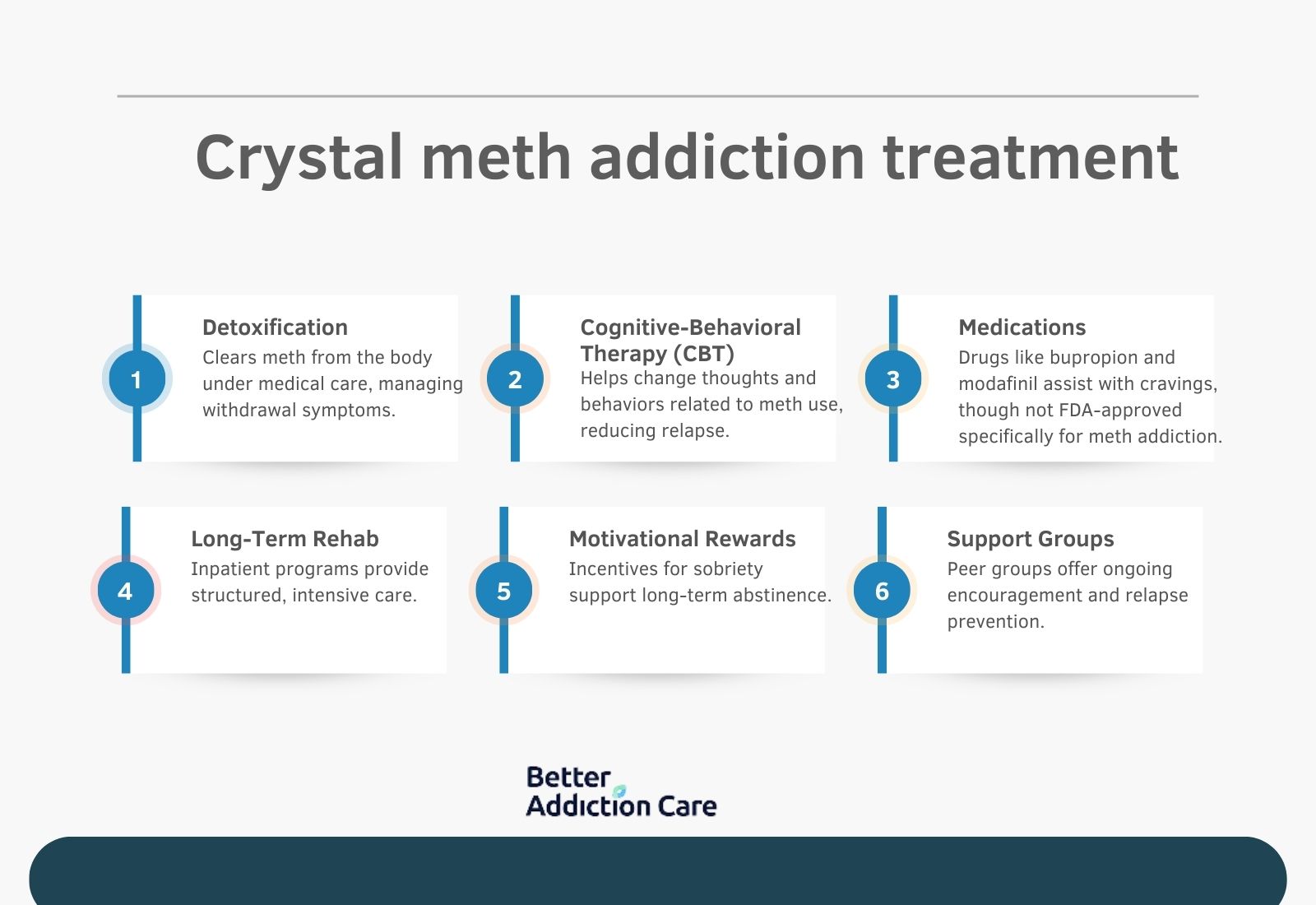
The treatment methods for crystal meth addiction are detoxification, cognitive-behavioral therapy (CBT), medications, long-term rehab programs, motivational rewards, and support groups.
These treatment methods are described below.
-
Detoxification: Detoxification is the first step in meth addiction recovery that involves cleansing the body of meth under medical supervision. Detox takes about 7-10 days to effectively manage withdrawal symptoms. While detox is important, this step is extremely difficult due to intense cravings.
-
Cognitive-Behavioral Therapy (CBT): CBT is a form of behavioral therapy, usually conducted in one-on-one sessions by a medical professional to help addicted individuals recognize and change their thoughts related to meth use. CBT lasts several months and is effective in reducing relapse risks, as stated in the study “A systematic review of cognitive and/or behavioral therapies for methamphetamine dependence” by Nicole K Lee and Richard A Rawson.
-
Medications: While there are currently no FDA-approved medications specifically for meth addiction, certain medications, like bupropion and modafinil, help reduce cravings and withdrawal symptoms, as stated in the study “Pharmacological approaches to methamphetamine dependence: a focused review” by Laurent Karila and Aviv Weinstein. Medications support detox and therapy but may not address the root behavioral causes of addiction.
-
Long-Term Rehab Programs: Long-term rehab programs, such as inpatient or residential rehab programs provide a structured and supervised environment and range from 30 days to several months. Rehab programs offer intensive treatment and have high success rates, but they require significant time commitment and are costly.
-
Motivational Rewards (Contingency Management): Motivational rewards, pr contingency management provide incentives for staying sober, such as vouchers or small rewards. Motivational rewards programs last for months and are effective to treat meth addiction behavior.
-
Support Groups: Support groups like Narcotics Anonymous are essential for long-term recovery and decreasing the risk of relapse. Support groups are joined group meetings with people going through the same addiction struggles. Individuals share their experiences and recovery journey to stay motivated.
What are the Withdrawal Symptoms of Crystal Meth Addiction?
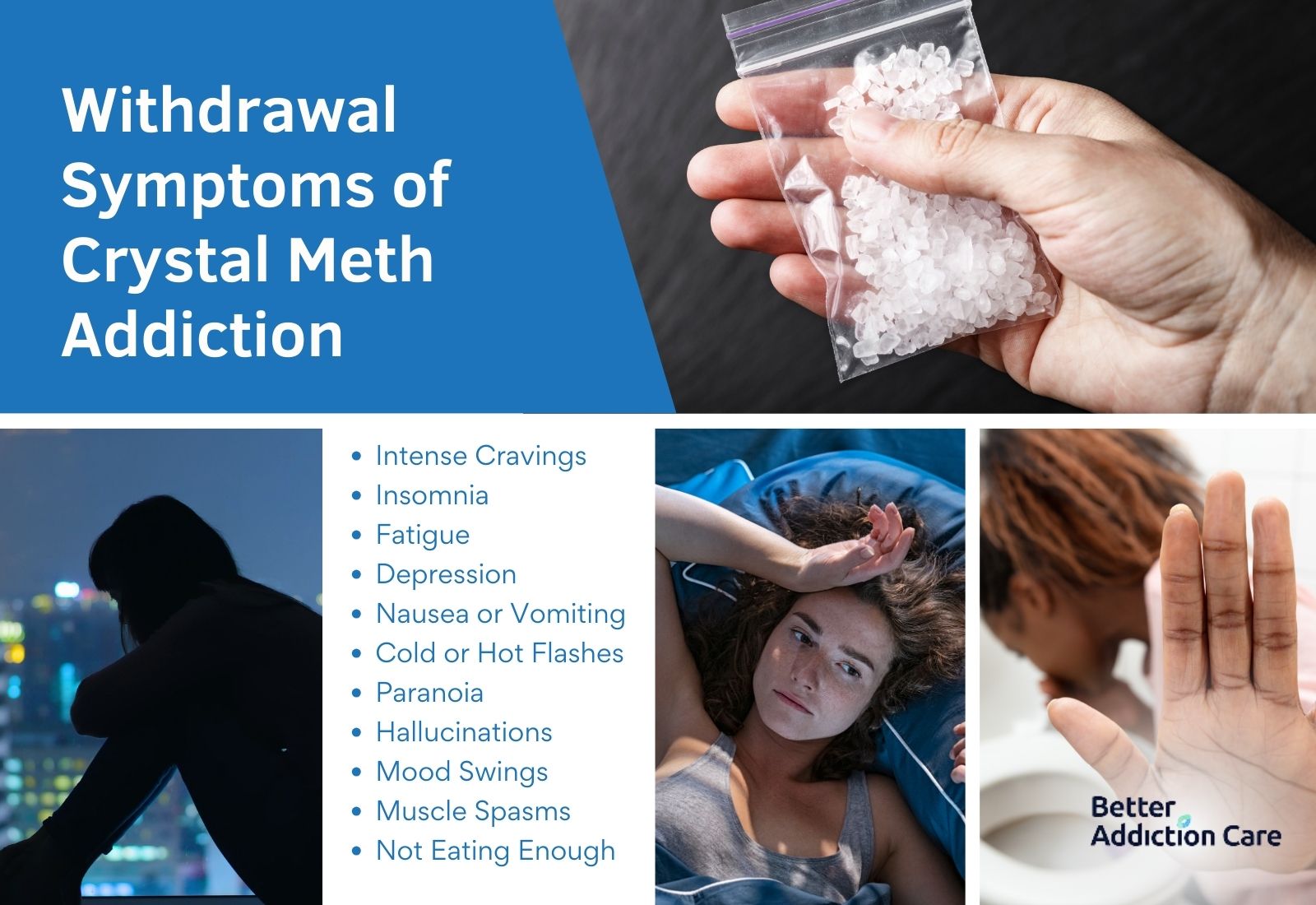
The withdrawal symptoms of crystal meth addiction are listed below.
-
Intense Cravings
-
Insomnia
-
Fatigue
-
Depression
-
Nausea or Vomiting
-
Cold or Hot Flashes
-
Paranoia
-
Hallucinations
-
Mood Swings
-
Muscle Spasms
-
Not Eating Enough
What are the Risks of Overdose of Methamphetamine?
The risks of an overdose of methamphetamine are heart attacks, organ failure, and fatality. The chances of overdose risks increase due to high doses or frequent and intense use. Overdose leads to heart attacks as the drug sharply raises blood pressure and heart rate, placing extreme stress on the cardiovascular system. Meth may lead to organ failure, as it pushes organs like the liver and kidneys to dangerously high levels of strain. Organ damage is usually irreversible and is often accompanied by other health complications. A meth overdose is fatal as the body’s systems fail as methamphetamine overwhelms both the brain and the organs.
How Can You Prevent Crystal Meth Relapse?
You can prevent crystal meth relapse by focusing on strategies like building a support network, engaging in regular therapy, and setting up a routine of positive habits. Creating a network of friends, family, and support groups provides encouragement and accountability, making it easier to avoid meth use during challenging times. Regular therapy, such as cognitive-behavioral therapy (CBT), helps by addressing triggers and developing healthier responses to stress. Setting up a routine of positive habits like exercise, hobbies, and structured routines replaces old behaviors and gives you satisfaction as well.
How Does Crystal Meth Addiction Differ from Other Substance Addictions?
Crystal meth addiction differs from other substance addictions by how quickly it impacts the brain and how strongly the addiction develops for users. Meth causes a huge dopamine release, leading to an intense high that wears off fast, often pushing people to use more right away. This fast cycle and consumption pattern makes it harder to stop and creates dependency much faster than other drugs. Meth addiction often needs specific, long-term treatments to help with both the physical and mental recovery.
Do Crystal Meth and Heroin Affect the Brain and Body Differently?
Yes, crystal meth and heroin affect the brain and body differently. Meth is a stimulant that boosts energy and alertness by increasing dopamine levels, while heroin is a depressant that calms the body and blocks pain by binding to opioid receptors. The effects of heroin addiction are drowsiness and slowed breathing, while meth leads to hyperactivity and heightened heart rate.
Can Crystal Meth and Cocaine Be Used Together?
No, crystal meth and cocaine can’t be used together. Using crystal meth and cocaine together is dangerous and highly discouraged. Both drugs are powerful stimulants, so combining them puts extreme strain on the heart and central nervous system, raising the risk of heart attacks, anxiety, and weird behavior linked to cocaine addiction. The intense dopamine spikes from both drugs increase addiction potential and the chance of overdose.



